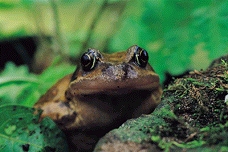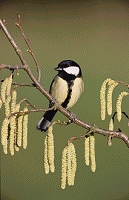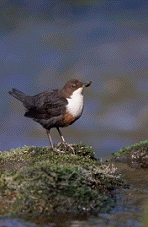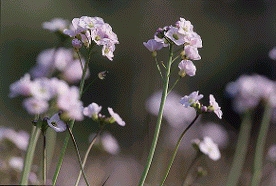Countryside Rangers Diary
February
When the sun shines it may seem for a moment that spring has arrived but this can soon be snatched away. Some of the worst winter weather over the past two decades has come during February. It is worth making the most of February's faltering steps, as spring gradually comes, with early-blooming flowers and early nesting birds leading the way.
 What's about in February?
What's about in February?
- Frogs return to ponds to spawn. Their activity reaches a peak this month.
- Toads, which are more vocal, start breeding a little later, beginning usually mid-month. You can spot them by shining a torch along the edge of a pond after dark.
- Brimstone butterflies are on the wing on warm days.
- Great and lesser-spotted woodpeckers drum.
- Hazel and alder catkins shed pollen this month. The tiny female flowers of alder are right at the tips of the branches. By winter they will be small woody cones releasing seed.
- Ravens and Herons are two of the earliest nesting birds. Both can be seen at Margam Park.
 This month is always good for snow; even the thinnest layer allows you to see some signs of activity that would otherwise go unnoticed. Get out early before the sun melts the tracks and pick up any trail that you find. As well as their route you should be able to pick up signs of feeding, droppings and other clues as to what they have been up to!
This month is always good for snow; even the thinnest layer allows you to see some signs of activity that would otherwise go unnoticed. Get out early before the sun melts the tracks and pick up any trail that you find. As well as their route you should be able to pick up signs of feeding, droppings and other clues as to what they have been up to!
Bad weather at this time of year has proved to be a real bird-killer. It hits the bird population hard as food reserves have already become depleted through the preceding months. The normal garden birds are usually better off as they already take food from feeders. If cold weather comes help your wrens, dunnocks and pied wagtails by putting out grated hard cheese, not too much! A little goes a long way to save them.
 Dippers are defending their breeding territories along our streams this month. They tend to perch along the edge of the streams on a favourite rock. Once one has established a territory it will not stray onto its neighbours patch. A good dipper population is a sign of a healthy river.
Dippers are defending their breeding territories along our streams this month. They tend to perch along the edge of the streams on a favourite rock. Once one has established a territory it will not stray onto its neighbours patch. A good dipper population is a sign of a healthy river.
The Cuckooflower, lady's smock Cardamine pratensis is the name of one of our most beautiful spring flowers. It produces its first flush of new foliage now. The plant is a member of the cabbage family and is an important food plant for the orange-tip butterfly caterpillars.
The occasional mild, spring-like day should bring a few early insects out of hiding. Look for brimstone, small tortoiseshell and peacock butterflies basking when the sun shines.
